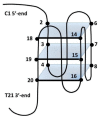Alkaloid Escholidine and Its Interaction with DNA Structures
- PMID: 34943140
- PMCID: PMC8698932
- DOI: 10.3390/biology10121225
Alkaloid Escholidine and Its Interaction with DNA Structures
Abstract
Berberine, the most known quaternary protoberberine alkaloid (QPA), has been reported to inhibit the SIK3 protein connected with breast cancer. Berberine also appears to reduce the bcl-2 and XIAP expression-proteins responsible for the inhibition of apoptosis. As some problems in the therapy with berberine arose, we studied the DNA binding properties of escholidine, another QPA alkaloid. CD, fluorescence, and NMR examined models of i-motif and G-quadruplex sequences present in the n-myc gene and the c-kit gene. We provide evidence that escholidine does not induce stabilization of the i-motif sequences, while the interaction with G-quadruplex structures appears to be more significant.
Keywords: DNA; G-quadruplex; alkaloid; cancer; escholidine; spectroscopy.
Conflict of interest statement
The authors declare no conflict of interest.
Figures







References
-
- Rybakova S., Rajecky M., Urbanova J., Pencikova K., Taborska E., Gargallo R., Taborsky P. Interaction of oligonucleotides with benzo c phenanthridine alkaloid sanguilutine. Chem. Pap. 2013;67:568–572. doi: 10.2478/s11696-013-0340-x. - DOI
-
- Leitao da-Cunha E.V., Fechine I.M., Guedes D.N., Barbosa-Filho J.M., Sobral da Silva M. Protoberberine Alkaloids. In: Cordell G.A., editor. The Alkaloids: Chemistry and Biology. Volume 62. Academic Press; Cambridge, MA, USA: 2005. pp. 1–75. - PubMed
LinkOut - more resources
Full Text Sources
Research Materials

